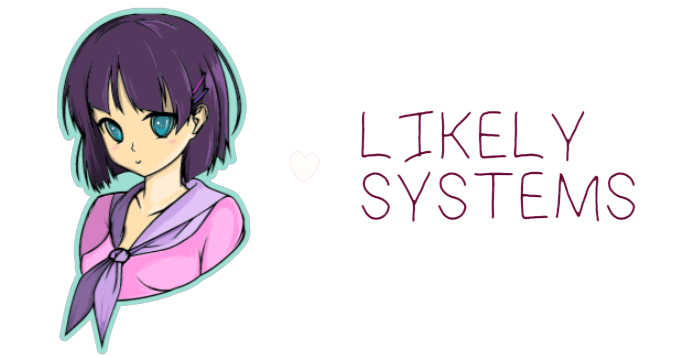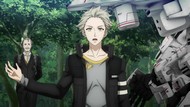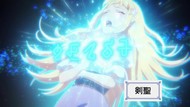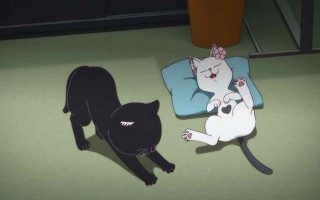Hello folks, and welcome back to Wrong Every Time. Today’s project is a bit unusual, as we are neither touching down on a new production nor continuing one of our existing journeys – instead, we’re plunking down right at episode 1089 of the long-running One Piece. As any followers of my twitter account likely know, I’ve spent the last few years diving ever-deeper into One Piece, and ultimately coming to appraise it alongside Hunter x Hunter as a superior and frankly incredible shonen production. The story’s scope, skill of execution, and constant creative embellishments make it a source of continuous wonder; it embodies the essence of cartooning while also succeeding as a grand fantasy epic, and I would recommend anyone who’s curious about it to at least check out the manga.
As for our current assignment, episode 1089 marks the transition from the long-lasting, feudal Japan-themed Wano arc to the current Egghead arc, which the anime production accompanied with a wholesale reimagining of the One Piece aesthetic. Gone are the formidable line weights and bright colors of Wano, replaced by delicate lines and pastels that harken back to One Piece’s original look. It’s a transition with a clear thematic intent: after the high dramatic peaks of Wano, Egghead is partially intended as a nostalgic return to form, a reminder of the freewheeling “what will the next island hold” spirit that once characterized this production. From their arrival at the second half of the Grand Line through Wano, Luffy and his companions’ course was largely directed by their alliance with fellow pirate Trafalgar Law – but now that the goals of that alliance have been achieved, the Straw Hats are again free to sail wherever the winds might take them. Let’s get to it!
Episode 1089
We begin with a fresh new opening, immediately demonstrating Egghead’s visual style through a director whose tendencies might well have inspired it: Megumi Ishitani, Toei’s most impressive upcoming director. I’ve talked about Ishitani’s absurd strengths at length, but in brief I can confidently say she is a generational talent, someone who understands both the finer points of cinema and the unique storyboarding tricks that make animation seem like genuine magic. Ishitani often dispenses with line art almost entirely, favoring pure splashes of color given form through contrast and movement, making her an ideal vanguard for announcing this new saga
Alongside Ishitani, this new OP is sung by Hiroshi Kitadani, who is as much of a One Piece legend as any actual singer could hope to be. Kitadani provided One Piece’s original “We Are!” opening, an OP so iconic it’s still persistently used to accompany moments of great drama or release within the show, and has returned over the years to provide a variety of other excellent OPs for One Piece, including the recent Over the Top. This current OP “Us!” might actually be my favorite of his contributions, featuring a swelling choral backing that builds up around his traditional manic verse delivery, all culminating in the very One Piece ideal of “all of us, dream save us” – that the audacity of our hopes might carry us to an impossible future
The OP is rich in color and constantly moving, the consistent flow of images embodying Ishitani’s talent for using motion and match cuts in order to both illustrate thematic parallels and create a consistent sense of momentum. It’s no surprise that her directorial contributions to One Piece have mostly involved either globe-trotting episodes of narrative exposition or OPs – Ishitani’s ability to synthesize loosely arrayed dramatic information into a coherent, evocative whole is second to none, and animators who work with her have acknowledged what a close role she plays in the precise storyboarding of her sequences. She would be wasted on an action-heavy episode, because action-heavy episodes are led more by the tendencies of individual star animators than the dictates of someone who sees a holistic episode vision as clearly as Ishitani
It is through Ishitani’s coherence and clarity of perspective that this immensely information-rich OP feels coherent and exciting rather than overwhelming. As in her previous OP, she maintains visual clarity through themed match cuts, often favoring compositions with a central circle to guide the eye, or having the the characters on-screen pan with a continuous sense of motion between cuts
Other highlights here: scale and perspective. The enormity of some of this arc’s sequences is conveyed through low-angle or character perspective-aligned camerawork, while clarity is again maintained through the steady twisting of shot perspective in single coherent directions even between match cuts
The camera movement often matches the energy of the characters themselves, like in this sequence where only the lighting shifts as Luffy slowly marches forward, then the frame twists with increasing speed as he breaks into a run. All of this contributes to the OP’s inherent sense of joy, its visceral Luffy-life glee at bounding towards a mysterious new island
The quick, music-timed match cuts also help condense a great deal of information, as in this sequence of Kidd, Law, and various other characters rising to swing another punch – a choice that doesn’t just celebrate all these characters, but also emphasizes the bond between them, the “all of us” implied by the song
“Entering a New Chapter! Luffy and Sabo’s Paths!”
The opening to this new chapter is a celebration of character acting, with the secret revelation of Luffy’s dream offering a natural opportunity for all of them to be their diversely expressive selves. One Piece has many strengths, but perhaps its most obvious and essential is its remarkable core cast of characters, who are essentially peerless in shonen in terms of actually behaving like a varied yet charming and mutually affectionate group of friends
The layouts are also smartly designed here, with the camera frequently positioned in such a way as to look across the Thousand Sunny, offering a sense of genuine, multilayered space that further accentuates the affectionate coziness of the moment
Robin reminds the party that their last Road Poneglyph, essentially the last portion of the treasure map leading them to the end of the Grand Line, has never been found, and thus cannot simply be targeted and visited like the others. In a part of proud lunatics, Robin is frequently framed as the adult in the room, the one who’s actually managing their pursuit of their goals. A small fragment of the plentiful distributions of duty that make the Straw Hats feel like a cohesive, mutually dependent whole
A seagull carries us to the new Marine Headquarters, where marines are intercepting communication from Luffy’s brother Sabo, dubbed the “Flame Emperor” due to his acquisition of Ace’s fire powers
Clouds then offer a wipe pan to Big News Morgans, continuing a sense of momentous visual escalation echoing Ishitani’s approach to the OP. After serving as unit director on One Piece: Stampede, episode director Nozomu Shishido’s profile has clearly risen precipitously, leading to him being rightfully trusted with this key transition episode
Morgans offers a quick recap of recent events, likely a concession to this episode being the first reasonable onboarding point for new fans since the beginning of Wano half a decade ago. Of course, this is still a preposterous point to start One Piece, but artists must nonetheless pay some deference to the lunacy that prompts audiences to declare “no, I just want to start on the most recent chapter”
If anything, Morgans’ monologue will at least hopefully convince a few potential viewers there’s so much context they’re missing that they really ought to start elsewhere
Our next stop is Marijoa, the seat of power for the World Government, where the Five Elders that allegedly rule this world await further news of Sabo’s broadcast. The conjoining wipe cuts emphasize the narrative alignment of this moment – disparate threads like the revolutionary army and world government are finally merging into a single narrative thrust, the culmination of a narrative structure decades in the making. Considering One Piece’s scale, as well as the fact that Oda has had to write and release it on a weekly schedule, it is truly absurd that the whole structure hangs together so well
They hear that Sabo’s location is Lulusia, a country that just recently underwent a revolutionary upheaval
This information is also relayed to the mysterious Imu, the figure seated upon the allegedly empty throne representing the equal voices of all world government nations
Sabo’s call at last reaches the revolutionary government. Koala takes the call, a girl who embodies the long arc of One Piece’s ambitions, her history tied into both the racially motivated bloodshed of Fishman Island and the eventual liberation of Dressrosa
More shots of Imu, vague, portentous, and beautiful. We never see him fully, only at a distance or in partial shots, like his shadowed hand. He resides in a garden of flowers and butterflies, delicate things that seem to emphasize that if he were to tighten his grip, he could destroy anything within his domain
Imu’s judgment is represented as a nightmare intrusion on reality; the butterfly he released captured in inverted colors, in grainy soft focus, in saturated light. Through these tools, alongside an ominous low-angle panning cut around Imu itself, the production emphasizes the otherworldly power Imu controls
“Lulusia? There was no such country in the first place.” After a thousand episodes of holding back the World Government’s true power, the Five Elders move to destroy a country entirely – and not just destroy it, but erase it from the historical record. An act that falls perfectly in line with the destruction of Obara, Robin’s land of scholars, and which on a larger time frame emphasizes their culpability in the existence of the “void century,” a hundred years that they managed to entirely scrape from the historical record. Control over how history is written is the ultimate power, the ability to shape reality and human thought, and seeing the World Government flex this power so flagrantly only emphasizes how close both Sabo and Luffy have come to disrupting their plans
This act of destruction also serves as the first indication that Egghead will essentially be a companion piece to the destruction of Ohara. Egghead will simultaneously reprise three crucial One Piece moments: the Enies’ Lobby clash with Cipher Pol, the Sabaody defeat against Kizaru, and the destruction of Ohara. In all cases, it will serve as a reminder of how far our heroes have come, as they triumph over old rivals and challenge old assumptions, discovering they are strong enough now not just to fight for their own sake, but to complete the grand work that Ohara was striving towards
There are countless reasons it would be a silly idea to hop on One Piece for Egghead, but personally, the lack of context for Robin’s small asides here is one I simply can’t imagine. Perhaps my favorite moment of this arc is when Vegapunk’s recollections of Ohara bring Robin to tears, and her allies immediately leap to her defense, reminding her that her old friend’s words came true: “ain’t no one born into this earth to be alone”
Thus Lulusia is cast into the sea, another senseless victim of the World Government’s desperation to maintain information control. One Piece’s profound scale and refusal to simply abandon old characters help to ensure that information warfare is a key, impactful element of its drama. Its world is constructed with enough care that the thought “I can’t wait until the public hears about this” naturally accompanies many of its most titanic moments
Several days later, the Thousand Sunny skims the crests of waves within a massive storm, the wind and cold facilitating delightful flourishes of character acting across the main cast. We also receive the easy payoff of the Straw Hats at long last again embodying their roles as crewmates, with Jimbei at the helm, Nami navigating at his side, and Franky keeping the ship from falling apart
The animation is loose and fluid, the forms of the characters melting and reforming in vague blobs – an intentional far cry from the clearly defined, thick-lined forms of Wano, instead emphasizing the natural humor of their expressive, exaggerated body language. The contrast between Wano and Egghead’s art design and animation priorities offers a clear demonstration of how such choices can themselves imply tone or genre; Egghead’s freewheeling animation is a perfect match for its lighthearted tone
“Oh, you look good, Chopper,” Robin applauds as he heads out to help the team. One of the main reasons the Straw Hats feel so lively and loving, so cohesive and meaningful as an overall unit, is that every member of the team has distinct dynamics with almost every other member of the team. Robin admires Luffy as an irrepressible dreamer, loves Chopper like an adorable little brother, respects Zoro’s conviction, often finds Franky vulgar or tedious, relies on Jimbei’s mature wisdom, and has similarly distinct opinions on the rest of the Straw Hats, a richness of perspective that applies to all of the Straw Hats. They are not simply all similarly bonded to Luffy, they have a rich array of internal family dynamics
Suspended above the waves before them, they see a vast orb of water with a golden light radiating within it. Oda has developed uncountable hooks to draw this narrative forward, but nonetheless also respects the essentiality of consistent intriguing pitches like this, moments of wonder and discovery to capture our imagination. There is basically never a dull or predictable moment in this world
Luffy is the first to spy a figure in the water, always quick to respond when someone’s in danger. Of course, he’s swiftly followed by Sanji, who has a supernatural talent for hearing ladies in jeopardy
The composition work continues to impress, with the snow overlay and carefully deployed soft focus creating a sense of cinematic scale and commotion as the crew spring into action
The storyboarding immediately shifts when Zoro takes the stage, offering longer-held closeups that emphasize his mental calm in the eye of the storm. Zoro is the rock within the Straw Hats; the least complex in terms of both personality and history, the iron pole that ensures the captain’s will be done
His clarity is contrasted against visual chaos as Chopper emerges, smears and wild exaggerations of Usopp’s face accompanying him being carried away in the wind
But the wildest smears of all are reserved for the reveal of Jewelry Bonney, one of Luffy’s rivals among the “Worst Generation” of infamous upcoming pirates. Oda is a master of long-term narrative planning, but part of that comes down to his incredible knack for planting fertile seeds. I can’t imagine he had specific plans for each member of the Worst Generation when he introduced them back in Sabaody, but he has since skillfully inserted them one by one, adding a glimmer of nostalgic recognition and thrill of forward-facing emergent solidarity to all the islands of One Piece’s second half. Bonney is one of the last to receive a guest starring role, and she certainly makes the most of it
Bonney gracefully introduces our stinger – a giant fucking shark, on the verge of swallowing the Sunny!
And Done
Ah, that’s a fun one to revisit. The introduction to Egghead is a dazzling statement of purpose, introducing its delightful new art direction while emphasizing the continuity and increasing momentum of drama all across the world of One Piece. Oda’s story embodies the absurd dramatic heights that the diligent long-form storytelling of manga can reach, a pinnacle so distant and impressive that it’s frankly no surprise to me only he and Togashi have reached it (at least, in my viewing experience). It is preposterous that One Piece has gone on this long with such confidence, rising so consistently in scale and emotional impact, and it is a singular quirk of animation history that it is currently blessed with an adaptation so eminently worthy of its grandeur. Animators who grew up on One Piece are now charting new visual ground in bringing its wonders to life, and Egghead demonstrates the miracles of this alliance with its every episode. Dream save us indeed!
This article was made possible by reader support. Thank you all for all that you do.




